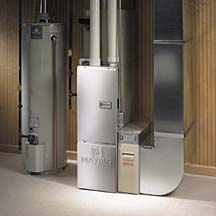For one manufacturer, a premium furnace encompasses all of the above, as well as improved igniter technology. Nordyne, St. Louis, MO, manufacturer of furnaces bearing the premium brand names Maytag, Tappan, Frigidaire, Philco, and Westinghouse, decided to tackle the issue of premature igniter burnout two years ago.
The new ignition system, called “Smartlite,” can be found on all Nordyne furnaces. However, the company says customers will experience a new level of comfort when they purchase a furnace that not only includes the Smartlite system but also has the other features found only on its high-end furnaces.

WE HAVE IGNITION
Contractors often cite premature igniter burnout as one of the biggest problems they encounter on all furnaces. Even with hot surface ignition technology, which is the type Nordyne uses, burnout can be a problem. In most furnaces, the igniter comes on for an average of 30 seconds, even though the igniter is up to the ignition temperature before 30 seconds. Unfortunately, an igniter is like a light bulb: The longer it runs, the quicker it’s going to die.“In our systems, the very first time the furnace starts, the igniter is powered for 30 seconds. Then each subsequent time there’s a call for heating, it subtracts 3 seconds off the amount of time the igniter stays on,” says Dennis Kloster, Nordyne vice president of Marketing and Sales for Residential and Light Commercial.
Obviously, if 3 seconds are subtracted each time, there will come a time when the igniter doesn’t ignite the gas because it’s not hot enough. When it gets to that point, the Smartlite system adds 3 seconds on to the ignition timing, then stabilizes. The result is that it’s not unusual to have a Smartlite igniter coming on for 9 or 12 seconds instead of the usual 30 seconds.
“You can’t necessarily say you’ve doubled the igniter life, because it’s a function of how many times it comes on and off and how long it’s on each time. But you’ve significantly increased the life of the igniter,” said Kloster.
Furthermore, as igniters age in service, their heat-up rate slowly decreases until they must be replaced. The Smartlite system can stay powered up for as long as 54 seconds, thereby extending the igniter life even longer.
Kloster says the Smartlite was designed in response to contractors who repeatedly asked why manufacturers couldn’t come up with an igniter that lasted multiple heating seasons. “We’ve come up with a way to fix this problem that’s economical, and from a sophistication standpoint, it’s not so complicated that you’ve got some mysterious black box. It’s a very high-reliability system that’s also self-correcting and self-compensating.”
Contractors have been pleased with the new system, says Kloster, noting that eliminating callbacks for burned-out igniters preserves profit margins, especially in new construction, where margins are tight.
TWO-STAGE
Nordyne provides additional features on its high-end furnaces. In particular, the company’s 90% and 92% AFUE condensing gas furnaces offer two-stage variable-speed technology.The two-stage option allows the furnace to run on low speed for the majority of the time, resulting in a quieter furnace that runs for longer periods of time than a single-speed furnace. The longer run time is a benefit because there are fewer on/off cycles and smaller temperature fluctuations (often one or two degrees, the company said). In addition, air circulation is improved and there are fewer drafts.
The furnaces offer simple two-stage gas operation with a constant-speed inducer blower. The second stage is accomplished by the addition of a solenoid valve to the gas manifold. “The solenoid valve simply turns on and off the gas flow to some of the burners to control the heating capacity,” said Kloster. “Gas pressure is continuously maintained at 3.5-inches water column by the gas valve.
“We go with all standard components, and we provide the two-stage capacity with a much simpler and much more reliable design. We use pretty much all off-the-shelf components, with the addition of the solenoid valve.”
The variable-speed blower motor is a big benefit to consumers, because it optimizes humidity removal and filtration capabilities, resulting in improved air quality and reduced air stratification. Kloster notes that these are all benefits that contractors can share with customers when trying to sell them up to a higher efficiency furnace.
Selling higher efficiency furnaces is usually a no-brainer in replacement markets in the northern United States, where there are high heating loads. Elsewhere, Kloster said contractors should tout the benefits listed above, as well as the installed cost of an 80% AFUE furnace vs. a 90% AFUE furnace.
“There’s a noticeable cost difference with a 90% furnace, where you run PVC venting, vs. putting in an 80% furnace with double-wall venting. A 90% furnace costs a lot less to vent than an 80% furnace. So contractors should make sure they look at the total installed cost of the furnace and the venting system, not just the furnace alone,” notes Kloster.
It’s definitely worthwhile to educate customers about the advantages of 90%-plus furnaces.
Publication date: 11/25/2002


Report Abusive Comment